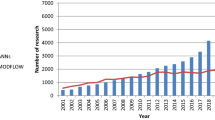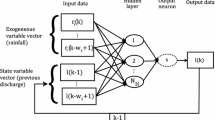Abstract
A fundamental aspect in groundwater heat pump (GWHP) plant design is the correct evaluation of the thermally affected zone that develops around the injection well. This is particularly important to avoid interference with previously existing groundwater uses (wells) and underground structures. Temperature anomalies are detected through numerical methods. Computational fluid dynamic (CFD) models are widely used in this field because they offer the opportunity to calculate the time evolution of the thermal plume produced by a heat pump. The use of neural networks is proposed to determine the time evolution of the groundwater temperature downstream of an installation as a function of the possible utilization profiles of the heat pump. The main advantage of neural network modeling is the possibility of evaluating a large number of scenarios in a very short time, which is very useful for the preliminary analysis of future multiple installations. The neural network is trained using the results from a CFD model (FEFLOW) applied to the installation at Politecnico di Torino (Italy) under several operating conditions. The final results appeared to be reliable and the temperature anomalies around the injection well appeared to be well predicted.
Résumé
Une question essentielle dans la conception d’un système de pompe à chaleur en aquifère (SPCA) est l’évaluation correcte de la zone impactée thermiquement, qui se développe autour du puits d’injection. Ceci est particulièrement important pour éviter l’interférence avec des usages antérieurs d’eaux souterraines (forages) et des structures souterraines. Les anomalies de température sont détectées à partir de méthodes numériques. Les modèles numériques de dynamique des fluides sont largement utilisés car ils permettent de calculer l’évolution temporelle du panache thermique produit par la chaleur de la pompe. L’utilisation des réseaux de neurones est proposée afin de déterminer la série temporelle de la température de l’eau souterraine à l’aval de l’installation en fonction des profils possibles de la pompe à chaleur. L’avantage principal de la modélisation par réseau de neurones et la possibilité d’évaluer un grand nombre de scénarios en un temps limité, ce qui est très utile pour les analyses préliminaires nécessaires aux multiples installations futures. Le réseau de neurones est entraîné en utilisant les résultats du modèle de dynamique des fluides (FEFLOW) appliqué à l’installation du Polytechnique de Turin (Italie) pour plusieurs conditions d’exploitation. Les résultats définitifs semblent fiables et la prédiction des anomalies de température autour du puits d’injection est de bonne qualité.
Resumen
Un aspecto fundamental en el diseño de una planta para el bombeo de calor del agua subterránea (GWHP) es la evaluación correcta de la zona afectada termalmente que se desarrolla alrededor del pozo de inyección. Esto es particularmente importante para evitar interferencias con los usos previamente existentes del agua subterránea (pozos) y con estructuras del subsuelo. Las anomalías de la temperatura se detectan a través de métodos numéricos. Los modelos computacionales de la dinámica de fluidos (CFD) son ampliamente usados en este campo debido a que ellos ofrecen la oportunidad para calcular la evolución temporal de la pluma termal producida por el bombeo de calor. Se propone el uso de redes neuronales para determinar la evolución en el tiempo de las temperaturas del agua subterránea corriente abajo de una instalación en función de la posible utilización de perfiles de bombeo de calor. La ventaja principal del modelado de red neuronal es la posibilidad de evaluar un gran número de escenarios en tiempos muy cortos, lo cual es muy útil para el análisis preliminar de futuras instalaciones múltiples. La red neuronal está entrenada usando los resultados de un modelo CFD (FEFLOW) aplicado a la instalación en el Politécnico de Torino (Italia) bajo varias condiciones de operación. Los resultados finales parecen ser confiables y las anomalías de temperatura alrededor del pozo de inyección parecen ser correctamente predichas.
Resumo
Um aspeto fundamental do projeto de instalações de bombas de calor em água subterrânea (BCAS) é a correta avaliação da zona termicamente afetada que se desenvolve em torno do furo de injeção. Isto é particularmente importante para evitar a interferência com anteriores usos da água subterrânea (furos) e estruturas subterrâneas. As anomalias de temperatura são detetadas através de modelos numéricos. Os modelos de dinâmica de fluidos computacional (DFC) são amplamente usados neste campo uma vez que oferecem a oportunidade de calcular a evolução temporal da pluma térmica produzida por uma bomba de calor. Propôs-se a utilização de redes neuronais para determinar a evolução temporal da temperatura da água subterrânea a jusante de uma instalação como uma função dos perfis de utilização possíveis de uma bomba de calor. A principal vantagem da modelação com redes neuronais é a possibilidade de avaliação de um vasto número de cenários num curto espaço de tempo, o que é muito útil para uma análise preliminar de múltiplas instalações futuras. A rede neuronal foi treinada utilizando os resultados do modelo DFC (FEFLOW) aplicado à instalação existente no Politecnico di Torino (Itália) em diversas condições de operação. Os resultados finais parecem ser confiáveis e as anomalias de temperatura em torno do furo de injeção parecem ter sido bem previstas.












Similar content being viewed by others
References
Ahmad S, Simonovic SP (2006) An intelligent decision support system for management of floods. Water Res Manage 20:391–410
Ahmed JA, Sarma AK (2009) Artificial neural network model for synthetic streamflow generation. Res Water Manage 21:1015–1029
Banks D (2009) Thermogeological assessment of open-loop well-doublet schemes: a review and synthesis of analytical approaches. Hydrogeol J 17(5):1149–1155. doi:10.1007/s10040-008-0427-6
Bayer P, Saner D, Bolay S, Rybach L, Blum P (2012) Greenhouse gas emission savings of ground source heat pump systems in Europe: a review. Renew Sust Energ Rev 16(2):1256–1267. doi:10.1016/j.rser.2011.09.027
Chung JT, Choi JM (2012) Design and performance study of the ground-coupled heat pump system with an operating parameter. Renew Energ 42:1–2. doi:10.1016/j.renene.2011.08.054
Civita M, Lo Russo S, Vigna B (2004) Hydrogeological sketch map of Piemonte (NW Italy) 1:25.000. In: Map presented at the 32nd International Geological Congress (32IGC), Florence, Italy, August 21–28, 2004
Diersch HJG (2010) FEFLOW 6: user’s manual. WASY, Berlin
Firat M, Yurdusev MA, Turan ME (2009) Evaluation of artificial neural network techniques for municipal water consumption modeling. Water Res Manage 23:617–632
Florides G, Kalogirou S (2007) Ground heat exchangers: a review of systems, models and applications. Renew Energ 32:2461–2478. doi:10.1016/j.renene.2006.12.014
Freedman VL, Waichler SR, Mackley RD, Horner JA (2012) Assessing the thermal environmental impacts of an groundwater heat pump in southeastern Washington state. Geothermics 42:65–77. doi:10.1016/j.geothermics.2011.10.004
Fry VA (2009) Lessons from London: regulation of open-loop ground source heat pumps in central London. Q J Eng Geol Hydrogeol 42:325–334
Goetzler W, Zogg R, Lisle H, Burgos J (2009) Ground-source heat pumps: overview of market status, barriers to adoption, and options for overcoming barriers. Final report, Energy Efficiency and Renewable Energy - Geothermal Technologies Program, USDE, Washington, DC
Hagan MT, Menhaj MB (1994) Training feed-forward networks with the Marquardt algorithm. IEEE Trans Neural Netw 5(6):989–993
Hecht-Mendez J, Molina-Giraldo N, Blum P, Bayer P (2010) Evaluating MT3DMS for heat transport simulation of closed geothermal systems. Ground Water 48(5):741–756
Hertz J, Krogh A, Palmer RG (1991) Introduction to the theory of neural computing. Addison-Wesley, Redwood City, CA
Lo Russo S, Civita MV (2009) Open-loop groundwater heat pumps development for large buildings: a case study. Geothermics 38:335–345
Lo Russo S, Civita M (2010) Hydrogeological and thermal characterization of shallow aquifers in the plain sector of Piemonte region (NW Italy): implications for groundwater heat pumps diffusion. Environ Earth Sci 60:703–713. doi:10.1007/s12665-009-0208-0
Lo Russo S, Taddia G, Baccino G, Verda V (2011) Different design scenarios related to an open loop groundwater heat pump in a large building: impact on subsurface and primary energy consumption. Energy Build 43:347–357
Lo Russo S, Taddia G, Verda V (2012) Development of the thermally affected zone (TAZ) around a ground water heat pump (GWHP) system: a sensitivity analysis. Geothermics 43:66–74. doi:10.1016/j.geothermics.2012.02.001
Lund JW, Freeston DH, Boyd TL (2011) Direct utilization of geothermal energy 2010 worldwide review. Geothermics 40(3):159–180. doi:10.1016/j.geothermics.2011.07.004
McCulloch WS, Pitts W (1943) A logic calculus of the ideas immanent in nervous activity. Bull Math Biophys 5:115–133
Milenic D, Vasiljevic P, Vranjes A (2010) Criteria for use of groundwater as renewable energy source in geothermal heat pump systems for building heating/cooling purposes. Energy Build 42:649–657. doi:10.1016/j.enbuild.2009.11.002
Nam Y, Ooka R (2010) Numerical simulation of ground heat and water transfer for groundwater heat pump system based on real-scale experiment. Energy Build 42:69–75. doi:10.1016/j.enbuild.2009.07.012
Regione Piemonte (2007) Water protection plan. D.C.R. no. 117-10731, Turin, Italy (in Italian). http://www.regione.piemonte.it/acqua/pianoditutela/pta/aree/ai14/pdf/index.htm. Accessed May 7, 2010
Sarangi A, Bhattacharya AK (2005) Comparison of artificial neural network and regression models for sediment loss prediction from Banha watershed in India. Agric Water Manage 78:195–208
Self SJ, Reddy BV, Rosen MA (2012) Geothermal heat pump systems: status review and comparison with other heating options. Appl Energ 101(January):341–348. doi:10.1016/j.apenergy.2012.01.048
Singh RM, Datta B (2007) Artificial neural network modeling for identification of unknown pollution sources in groundwater with partially missing concentration observation data. Water Res Manage 21:557–572
Verda V, Baccino G, Sciacovelli A, Lo Russo S (2012) Impact of district heating and groundwater heat pump systems on the primary energy needs in urban areas. Appl Therm Eng 40:18–26
Yang QC, Liang J, Liu LC (2011) Numerical model for the capacity evaluation of shallow groundwater heat pumps in Beijing Plain, China. Procedia Environ Sci 10:881–889
Zhou Y, Zhou Z (2009) Simulation of thermal transport in aquifer: a GWHP system in Chengdu, China. J Hydrodyn 21:647–657
Author information
Authors and Affiliations
Corresponding author
Additional information
Published in the theme issue “Hydrogeology of Shallow Thermal Systems”
Rights and permissions
About this article
Cite this article
Lo Russo, S., Taddia, G., Gnavi, L. et al. Neural network approach to prediction of temperatures around groundwater heat pump systems. Hydrogeol J 22, 205–216 (2014). https://doi.org/10.1007/s10040-013-1072-2
Received:
Accepted:
Published:
Issue Date:
DOI: https://doi.org/10.1007/s10040-013-1072-2




